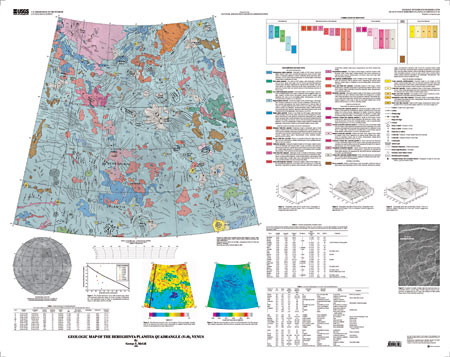


| INTRODUCTION The Bereghinya Planitia quadrangle (V-8) of Venus is bounded by 25º and 50º N. latitude, 0º and 30º E. longitude. It is one of 62 quadrangles covering the entire planet at a scale of 1:5,000,000. The quadrangle derives its name from the plains region Bereghinya Planitia, most of which falls within the boundaries of the quadrangle. Bereghinya are benevolent protective female spirits in East Slavic mythology. These spirits were considered as guardians of the home, and traditional homes commonly had carvings of Bereghinya around their windows. In addition, these spirits were associated with riverbanks, so some of them were envisioned as being women with fish tails, similar to mermaids. The Bereghinya Planitia quadrangle comprises mostly plains materials that have been highly modified by younger structures, mostly related to coronae. The map area contains all or part of 22 named coronae, 4 named deformation belts, and 2 major lava channel systems having extensive associated volcanic flows. In addition, other valles, a deformation belt, and coronae occur within the quadrangle but are unnamed. The quadrangle hosts 24 impact craters and 6 bright splotches believed due to explosive destruction of bolides in the atmosphere. Many of the impact craters have associated dark halos or parabolas, and four are accompanied by fields of secondary craters. Also present is a complex array of faults, fractures, and wrinkle ridges.The quadrangle is geologically The quadrangle is geologically interesting primarily because of the large population of coronae, many of which are connected to each other by belts of closely spaced, complex wrinkle ridges producing a spiderlike pattern in which the "bodies" are coronae and the "legs" are the connecting belts. These coronae were named "arachnoids" by members of the Soviet Venera team. The problems of more than local interest include the kinematics and dynamics of the arachnoids, the structural and volcanic evolution of the coronae, and the age of the widespread background plains relative to structures and other material units. |
Download this map as a PDF document (44 x 35 inches; 28.4 MB)
Download the accompanying pamphlet as a 19-page PDF document (304 KB)
| Help | PDF help | Geopubs main page | Other Planetary Maps |
| Privacy Statement | Disclaimer | Accessibility |
| Geologic Division | Astrogeology Research Program |
This map is also available from:
USGS Information Services, Box 25286,
Federal Center, Denver, CO 80225
telephone: 303-202-4210; e-mail: infoservices@usgs.gov